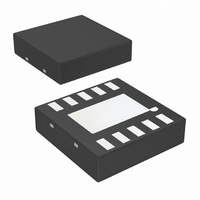LMV242LD/NOPB National Semiconductor, LMV242LD/NOPB Datasheet - Page 11

LMV242LD/NOPB
Manufacturer Part Number
LMV242LD/NOPB
Description
IC GSM POWER AMP CTRLR 10LLP
Manufacturer
National Semiconductor
Datasheet
1.LMV242LDNOPB.pdf
(16 pages)
Specifications of LMV242LD/NOPB
Rf Type
Cellular, GSM, GPRS, TDMA, TD-SCDMA, WLL
Frequency
450MHz ~ 2GHz
Features
Power Amplifier Controller
Package / Case
10-LLP
Lead Free Status / RoHS Status
Lead free / RoHS Compliant
Other names
LMV242LD
LMV242LDTR
LMV242LDTR
Application Section
POWER CONTROL PRINCIPLES
The LMV242 is a member of the power loop controller family
of National Semiconductor, for quad-band TDMA/GSM solu-
tions. The typical application diagram demonstrates a basic
approach for implementing the quad-band solution around
an RF Power Amplifier (PA). The LMV242 contains a 50 dB
Logamp detector and interfaces directly with the directional
coupler.
The LMV242 Base Band (control-) interface consists of 3
signals: TX_EN to enable the device, BS to select either
output 1 or output 2 and V
the specified level. The LMV242 gives maximum flexibility to
meet GSM frequency- and time mask criteria for many dif-
ferent single supply Power Amplifier types like HBT or Mes-
FET in GaAs, SiGe or Si technology. This is accomplished by
the programmable Ramp characteristic from the Base Band
and the TX_EN signal along with the external compensation
capacitor.
POWER AMPLIFIER CONTROLLED LOOP
This section gives a general overview and understanding of
how a typical Power Amplifier control loop works and how to
solve the most common problems confronted in the design.
General Overview
The key benefit of a PA control loop circuit is its immunity to
changes in the PA gain control function. When a PA control-
ler is used, the relationship between gain and gain control
RAMP
to set the RF output power to
FIGURE 1. PA Control Loop
11
voltage (V
transfer function. It is a function of the controller’s V
voltage. Based upon the value of V
will set the gain control voltage of the PA to a level that is
necessary to produce the desired output level. Any tempera-
ture dependency in the PA gain control function will be
eliminated. Also, non-linearity’s in the gain transfer function
of the PA do not appear in the overall transfer function (P
vs. V
function of the PA has to be monotonic. To achieve this, it is
crucial, that the LMV242’s detector is temperature stable.
Typical PA Closed Loop Control Setup
A typical setup of PA control loop is depicted in Figure 1.
Beginning at the output of the Power Amplifier (PA), this
signal is fed, usually via a directional coupler, to a detector.
The error between the detector output current I
ramp current I
drives the inverting input of an op amp, configured as an
integrator. A reference voltage drives the non-inverting input
of the op amp. Finally the output of the integrator op amp
drives the gain control input of the power amplifier, which
sets the output power. The loop is stabilized when I
equal to I
RAMP
RAMP
APC
). The only requirement is that the gain control
) of the PA is of no consequence to the overall
RAMP
. Lets examine how this circuit works in detail.
, representing the selected power setting,
20079528
RAMP
, the PA controller
DET
www.national.com
and the
DET
RAMP
OUT
is






